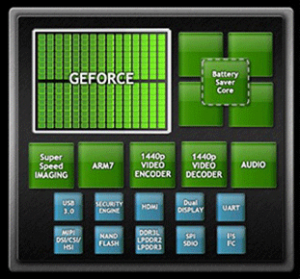

"What's all the hubbub, bub?"
This Tegra 4 SOC (system-on-a-chip) design carries 72 Nvidia GeForce GPUs (graphics processing units), which is six times the number on the Tegra 3 with its 12 GPUs.
The Tegra 4 also includes the world's first quad-core SOC integration of the Cortex-A15, which is ARM's most advanced CPU core.
Nvidia's Tegra 4 has a second generation battery-saver core. In addition to the quad-core, it is that fifth core that takes over light-duty tasks so the quad-core part of the chip can stand-down to save energy. Nvidia claims that allows "unprecedented power efficiency", giving it the capability of consuming just a little more than half as much power as the Tegra 3, and providing for as much as 14 hours of HD video playback on phones. Nvidia also utilizes a backlight power reduction scheme which it calls "Prism 2 display technology".
Nvidia is making available to manufacturers an optional chipset for the Tegra 4 that enables worldwide 4G LTE data and voice functionality using the Icera i500 processor which is less than half the size of conventional modems, while delivering "four times the processing capability of its predecessor". Nvidia's acquisition of Icera in 2011 was apparently an ideal marriage.
The Tegra 4 foreshadows increasingly high-density PPI counts (pixels-per-inch) on upcoming TVs, laptops, smartphones and tablets by providing support for ultra-high-definition video known by various names such as 4K, QuadHD, UltraHD, or UHD.
In spite of a host of other improvements "Computational Photography Architecture" is considered by Nvidia to be a "breakthrough" on the Tegra 4. That process combines the processing power of the CPU and GPU cores with the camera's image-signal processor to deliver high dynamic range (HDR).
In real-world terms that provides a solution to scenes with extreme contrast which, for example, may give a "washed-out" look to a sky background. The image improvements cause scenes to appear more the way the human eye perceives them by leaving detail intact in both dark and bright areas of scenes.
Nvidia's senior vice president of the Tegra business unit, Phil Carmack, put it this way: "Tegra 4 provides enormous processing power and efficiency to power smartphones and tablets, gaming devices, auto systems and PCs. Its new capabilities, particularly in the area of computational photography, will help improve a whole range of existing products and lead to the creation of exciting new ones."
Assessment
With the brute force of 72 GPU cores and substantial speed improvements, Nvidia's Tegra 4 is definitely not dancing the Hokey Pokey. Multiple mobile device manufacturing partners are lining up for an increasingly high-speed dance: and "that's what it's all about."

 Laptop & Tablet Parts
Laptop & Tablet Parts




















